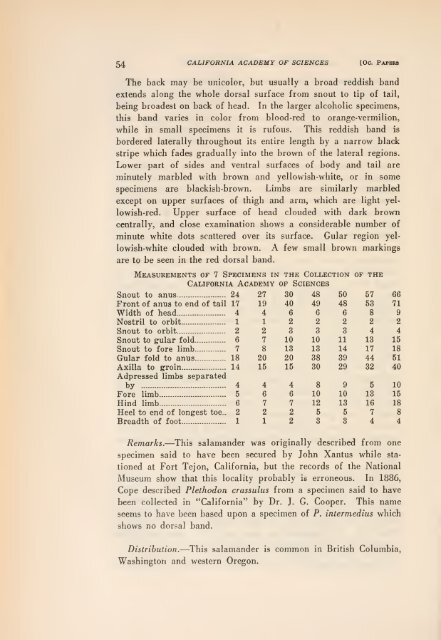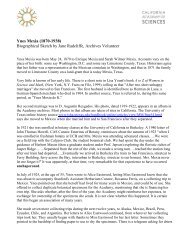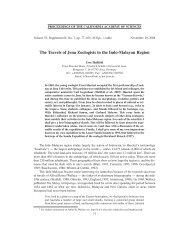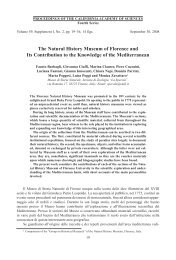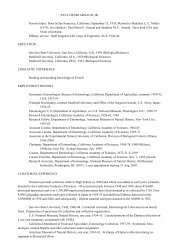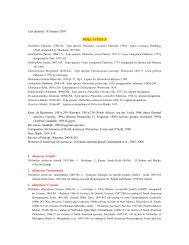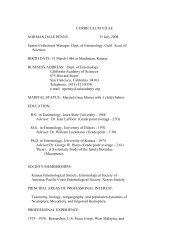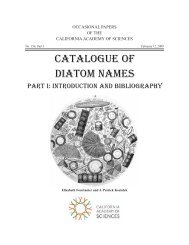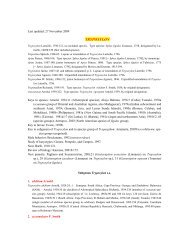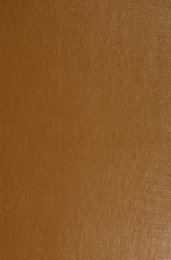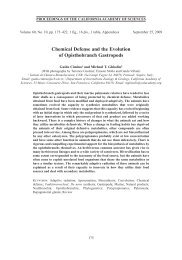PDF (9.91 MB) - Academy Research - California Academy of Sciences
PDF (9.91 MB) - Academy Research - California Academy of Sciences
PDF (9.91 MB) - Academy Research - California Academy of Sciences
You also want an ePaper? Increase the reach of your titles
YUMPU automatically turns print PDFs into web optimized ePapers that Google loves.
54,<br />
CALIFORNIA ACADEMY OF SCIENCES [Oc. Papbbs<br />
The back may be unicolor, but usually a broad reddish band<br />
extends along the whole dorsal surface from snout to tip <strong>of</strong> tail,<br />
being broadest on back <strong>of</strong> head. In<br />
the larger alcoholic specimens,<br />
this band varies in color from blood-red to orange-vermilion,<br />
while in small it<br />
specimens<br />
is rufous. This reddish band is<br />
bordered laterally throughout<br />
its entire length by a narrow black<br />
stripe which fades gradually into the brown <strong>of</strong> the lateral regions.<br />
Lower part <strong>of</strong> sides and ventral surfaces <strong>of</strong> body and tail are<br />
minutely marbled with brown and yellowish-white, or in some<br />
specimens are blackish-brown. Limbs are similarly marbled<br />
except on upper surfaces <strong>of</strong> thigh and arm, which are light yellowish-red.<br />
Upper surface <strong>of</strong> head clouded with dark brown<br />
centrally, and close examination shows a considerable number <strong>of</strong><br />
minute white dots scattered over its surface. Gular region yellowish-white<br />
clouded with brown. A few small brown markings<br />
are to be seen in the red dorsal band.<br />
Measurements <strong>of</strong> 7 Specimens in the Collection <strong>of</strong> the<br />
<strong>California</strong> <strong>Academy</strong> <strong>of</strong> <strong>Sciences</strong><br />
Snout to anus 24 27 30 48 50 57 66<br />
Front <strong>of</strong> anus to end <strong>of</strong> tail 17 19 40 49 48 53 71<br />
Width <strong>of</strong> head 4 4 6 6 6 8 9<br />
Nostril to orbit 112 2 2 2 2<br />
Snout to orbit 2 2 3 3 3 4 4<br />
Snout to gular fold 6 7 10 10 11 13 15<br />
Snout to fore limb 7 8 13 13 14 17 18<br />
Gular fold to anus 18 20 20 38 39 44 51<br />
Axilla to groin 14 15 15 30 29 32 40<br />
Adpressed limbs separated<br />
by 4 4 4 8 9 5 10<br />
Fore limb 5 6 6 10 10 13 15<br />
Hind limb 6 7 7 12 13 16 18<br />
Heel to end <strong>of</strong> longest toe.. 2 2 2 5 5 7 8<br />
Breadth <strong>of</strong> foot 112 3 3 4 4<br />
Remarks.— This salamander was originally described from one<br />
specimen said to have been secured by John Xantus while stationed<br />
at Fort Tejon, <strong>California</strong>, but the records <strong>of</strong> the National<br />
Museum show that this locality probably<br />
is erroneous. In 1886,<br />
Cope described Plethodon crassulus from a specimen said to have<br />
been collected in "<strong>California</strong>" by Dr. J. G. Cooper. This name<br />
seems to have been based upon a specimen <strong>of</strong> P. intermedius which<br />
shows no dorsal band.<br />
Distribution.— This salamander is common in British Columbia,<br />
Washington and western Oregon.


